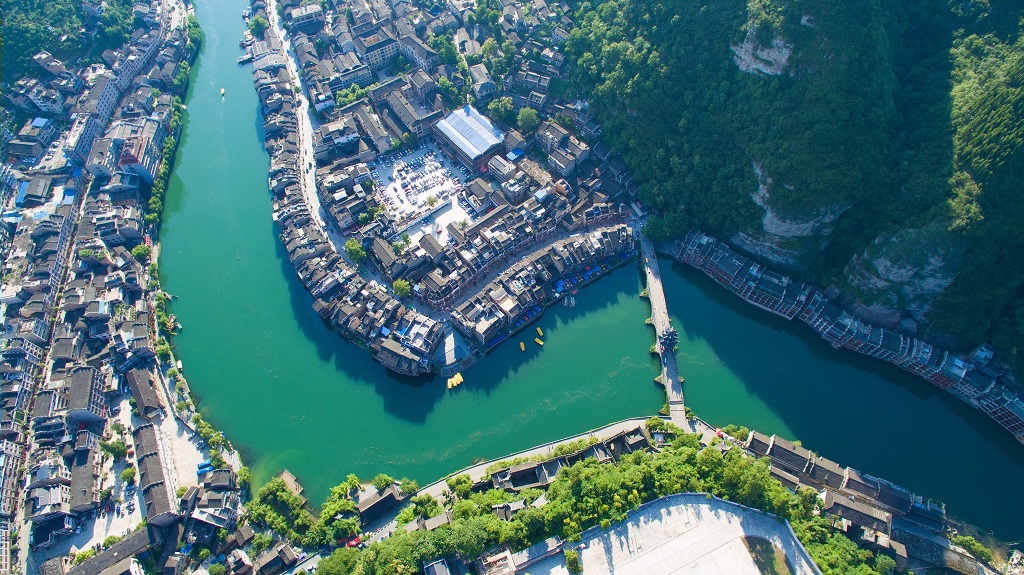- Profile Jurisdictions GOV DEPARTMENTS Cultures Travelling Educate
-
Zhenyuan is located in eastern Guizhou Province, at the junction of three regions in Hunan and Guizhou provinces (Huaihua in Hunan, Qiandongnan and Tongren in Guizhou). It borders Xinhuang County in Hunan, Shiqian and Yuping Counties in Tongren, and Cengong, Sansui, Jianhe, and Shibing Counties in our prefecture. It is known as the “Gateway to Yunnan and Hunan, and the Gateway to Eastern Guizhou.” The county covers a total area of 1,878 square kilometers, comprising 8 towns, 4 townships, 1 provincial-level economic development zone, 110 administrative villages, and 19 residential communities. It has a total population of 275,000, with ethnic minorities accounting for 50.2%.

Zhenyuan boasts a rich historical heritage, picturesque natural landscapes, a fusion of diverse cultures, and abundant tourism resources. Since its establishment as a county during the fifth year of Emperor Gaozu of Han (202 BCE), it has a history of over 2,200 years. In 1986, it was designated as a National Historical and Cultural City by the State Council. In 2016, it was designated as a revolutionary old area by the Provincial Party Committee and Provincial Government. In 2020, Zhenyuan Ancient City was designated as a National 5A-Level Tourist Attraction by the Ministry of Culture and Tourism, and it enjoys the titles of “China's Most Influential Tourist County,” China's Top Ten Tourist Ancient Cities,“ and ”China's Ten Most Beautiful Ancient Cities.“ It has been called one of the ”Top Ten Best Tourist Destinations in the World for Returning to Nature“ by the World Tourism Fund Organization, ”The Last Haven for the Weary Human Soul“ by the United Nations World Tourism Organization, and ”China's Low-Carbon Tourism Demonstration Site" by the Asia-Pacific Tourism Federation. The county has now established 12 national-level cultural tourism brands, including the Chinese Historical and Cultural City—Zhenyan, the National 5A-rated Tourist Attraction—Zhenyan Ancient City, the National Scenic Area—Wuyang River, the National Agricultural Tourism Demonstration Site—Tiexi, the National Key Cultural Relics Protection Units—Qinglongdong Ancient Architectural Complex, the former site of the Japanese Anti-War Alliance “Peace Village” in China, Zhenyan City Wall, and Zhenyan Tianhou Palace, the National Intangible Cultural Heritage—Dragon Boat Racing and Baojing “March 3rd Festival,” the National Nighttime Cultural and Tourism Consumption Cluster Zone—Zhenyan Ancient City, and the National Tourism and Leisure Street—Zhenyan Ancient City Cultural Pedestrian Street. Additionally, there are 16 provincial-level cultural relic protection units and 78 county-level cultural relic protection units.

Zhenyuan has a pleasant climate and abundant natural resources. The county is located in the central part of the low mountainous and hilly region of eastern Guizhou, primarily characterized by karst topography, with a maximum elevation of 1,132 meters and a minimum elevation of 354 meters. It belongs to the subtropical monsoon humid climate zone, featuring a mild climate, abundant rainfall, distinct seasons, synchronized water and heat, no severe cold in winter, and no extreme heat in summer. The annual maximum temperature is 40°C, the minimum temperature is -5.3°C, the annual average temperature is 16.5°C, the annual average frost-free period is 315 days, the annual average sunshine duration is 1,144 hours, the annual average wind speed is 1.4 meters per second, and the annual average precipitation is 1,094 millimeters. The county is home to 122 rivers of various sizes, including the Wuyang River, Longjiang River, and Jiaoba River, with a total length of 806 kilometers and a total water resource volume of 1.183 billion cubic meters; The natural vegetation consists of subtropical evergreen broad-leaved forests, with a forest area of 118,000 hectares, a forest coverage rate of 62.79%, and a total standing timber volume of 6.53 million cubic meters. Wild plants are relatively abundant, with major rare tree species including the nationally protected first-class plant Taxus chinensis, Ginkgo biloba, and second-class protected plants such as Taxus chinensis var. tripartita, Cinnamomum camphora, and Zelkova serrata. Over 20 types of mineral resources have been discovered within the county, primarily including lead-zinc ore, bauxite, silica ore, and barite ore, with significant exploitable reserves.

Zhenyuan enjoys convenient transportation and a prominent geographical advantage. The county is traversed by the Xiang-Qian Railway and the Zhu-Liu Double-Track Railway, and is connected by the Shanghai-Kunming Expressway, the Yanrong Expressway, the Tianhuang Expressway, and National Highways G211, G320, and G551 National Highways. It is 55 kilometers from Kaili Huangping Airport, 170 kilometers from Tongren Phoenix Airport, and 250 kilometers from Guiyang Longdongbao Airport. It is also 41 kilometers from the high-speed rail station in Sansui, 73 kilometers from Tongren South Station, 125 kilometers from Kaili South Station, and 146 kilometers from Rongjiang Station.
Zhenyuan has a long history of industrial development and a strong industrial foundation. It is one of the birthplaces of modern heavy industry in China. The Qingxi Ironworks, established in the 11th year of the Guangxu reign (1885), was a product of the “Self-Strengthening Movement” of the late Qing Dynasty, and the “No. 1 Steel Ingot” is still housed in the Zhenyuan Museum. In 2000, our county established the Zhenyuan Qiandong Industrial Park with Qingxi Town and Yangping Town as its core; In April 2006, the Qiandongnan Prefectural Party Committee and Government approved the establishment of the Qiandong Circular Economy Industrial Zone; in January 2012, the Guizhou Provincial People's Government approved the establishment of the Guizhou Qiandong Economic Development Zone here. After years of development, a modern industrial system has been basically established, with brewing, recycled lithium resource utilization, and electronic component manufacturing as the main industries, and power, metallurgy, and building materials as the foundation.

In 2024, the county achieved a regional gross domestic product (GDP) of 7.49 billion yuan, representing a 4.0% increase. The per capita disposable income of urban and rural residents increased by 3.5% and 7.1%, respectively.
Embarking on a new journey and striving toward the 14th Five-Year Plan, Zhenyuan County adheres to Xi Jinping Thought on Socialism with Chinese Characteristics for a New Era as its guiding principle, thoroughly studies and implements the spirit of the 20th National Congress of the Communist Party of China and President Xi Jinping's important speeches during his inspection of Guizhou Province, and upholds high-quality development as the overarching principle, while maintaining a steady and progressive work approach. fully, accurately, and comprehensively implementing the new development philosophy, better balancing development and security, seizing major policy opportunities such as the Opinions on the Implementation of the New National Development Plan No. 2, the Opinions on Several Policy Measures to Support High-Quality Development in Ethnic Regions, and the Opinions on the Implementation of Measures to Support Qiandongnan Prefecture in Building a “Bridgehead,” focusing on the “Four New” initiatives to advance the “Four Modernizations,” cultivating new productive forces tailored to local conditions, shaping new advantages for high-quality development, and striving to write a new chapter in the practice of China's modernization in Zhenyuan County.
contact details
Tel:00-86-0855-5722101
Address:Zhenyuan County, Qiandongnan Miao and Dong Autonomous Prefecture, Guizhou Province, Xinglong Street Government Compound
Working hours:Monday to Friday: 8:30 AM to 12:00 PM, 2:00 PM to 5:30 PM (excluding public holidays)
